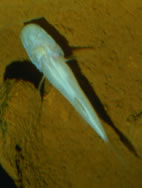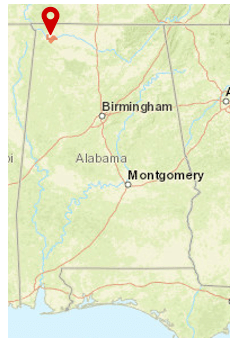Alabama cavefish facts for kids
Quick facts for kids Alabama cavefish |
|
|---|---|
 |
|
| Conservation status | |
| Scientific classification | |
| Genus: |
Speoplatyrhinus
|
| Species: |
poulsoni
|
 |
|
| The range of the Alabama cavefish | |
The Alabama cavefish (Speoplatyrhinus poulsoni) is a very rare fish that lives only in dark, underground pools. It is found in Key Cave, located in northwestern Alabama, United States. This special fish was first discovered in 1967 by scientists Robert A. Kuehne and John E. Cooper. They found it living near a group of gray bats. In 1974, it was officially named and described.
Scientists believe there are fewer than 100 Alabama cavefish left. This makes it one of the rarest freshwater fish in the world! They have looked in many other caves but haven't found this fish anywhere else. The Alabama cavefish lives in a delicate home that relies on nutrient-rich bat droppings, called guano, from the gray bats.
Not much is known about how these fish have babies or how long they live. However, experts think that when the cave floods, it helps the fish start their breeding cycle. So, if the flooding changes, it can be bad for the fish. The Alabama cavefish is in danger of disappearing forever. To help save it, laws like the Lacey Act protect it. Also, people are not allowed to disturb Key Cave, which is its main home.
Contents
Where the Alabama Cavefish Lives
The Alabama cavefish is one of the rarest cavefish in North America. We don't know all the exact things it needs to live, but we do know it can only survive in Key Cave in Lauderdale County, Alabama. This cave is its most important home.
Cave homes are usually very stable. Big changes mostly happen when water flows in. Rain and floods in the cave cause the water level, temperature, and food supply to change. Scientists think these floods might help the cavefish grow and reproduce.
Since this fish was found, only nine have ever been collected, all before 1983. Because so few have been seen, and they only live in Key Cave, the Alabama cavefish is thought to be the rarest American cavefish. It is also one of the rarest freshwater fish anywhere.
Scientists hoped the fish might have spread to other places because the underground water system is so big. But studies of 120 other caves since 1977 have not found any other Alabama cavefish. In Key Cave, no more than 10 fish have been seen during any single visit. The average was less than 4 fish per visit between 1967 and 1998. The total number of fish in Key Cave is thought to be less than 100.
The IUCN first called this fish "vulnerable." But as its extreme rarity became clear, its status was changed. Now, the Alabama cavefish is considered critically endangered. This means it faces a very high risk of extinction. Key Cave and a nearby cave, Collier Cave, are both protected and closed to the public.
Because it lives in only one cave, the Alabama cavefish faces an uncertain future. It is threatened by changes in groundwater quality and levels. It is also threatened by less food and competition from other fish. For example, it might compete with the Southern cavefish (Typhlichthys subterraneus), which is more common and aggressive. Also, cave crayfish sometimes eat Alabama cavefish.
What the Alabama Cavefish Looks Like
The Alabama cavefish is about 7.2 cm (2.8 in) long. It has no eyes and no color, so it looks almost clear with a slight pink tint. Its head is very large, making up more than one-third of its body length.
This fish is the only species in its group. You can tell it apart from other cavefish by its long, flat head. It also has a narrow snout and a mouth at the very front. The Alabama cavefish does not have pelvic fins. Its fin rays are not branched, and the fin membranes are deeply cut between the rays.
It has a special system of sensory bumps on its head and sides. These bumps are arranged in ridges. This helps the fish feel its way around in the dark cave environment. The Alabama cavefish has the most developed tail sensory bumps in its family, Amblyopsidae.
What the Alabama Cavefish Eats
The Alabama cavefish eats tiny creatures like copepods, isopods, and amphipods. It also eats smaller cavefish. Its food supply comes from the nutrient-rich bat guano. It can also survive by eating other small bugs like mites, spiders, millipedes, and beetles.
How the Alabama Cavefish Lives and Reproduces
We don't have much information about the life of the Alabama cavefish or how it reproduces. Scientists think that the Alabama cavefish might be a mouth-brooder. This means the mother might carry her eggs in her mouth until they hatch.
Like most fish, the Alabama cavefish uses seasonal clues to start its growth and reproduction. Most fish use big changes in water temperature or daylight. But the Alabama cavefish mainly relies on the cave flooding in winter and spring. This flooding brings more water into the cave and causes a small temperature change. These signals tell the cavefish to start reproducing.
Even with these signals, the Alabama cavefish does not reproduce every year. In years when they do have babies, a female only produces a few eggs. Scientists guess that the Alabama cavefish population grows much slower than the Northern cavefish. The Alabama cavefish is thought to live for about 5 to 10 years. However, this guess could be very different from reality.
Protecting the Alabama Cavefish
The Alabama cavefish is protected by a few important rules. It is listed under the Endangered Species Act (ESA). It is also protected by the Lacey Act. This law makes it illegal to buy, sell, or move Alabama cavefish, whether they are alive or dead. This includes their parts, eggs, or babies.
Also, the Tennessee Valley Authority, which owns the two entrances to the caves, has put up a fence. This helps stop people from disturbing the cave. In 1997, the Key Cave National Wildlife Refuge (NWR) was created. The Key Cave NWR works to protect the cave's natural health. It does this by protecting the sinkholes that carry surface water directly into the cave's underground water system.
How Humans Affect the Cavefish
The biggest threat to the Alabama cavefish from humans is water pollution. This pollution happens in the area where water seeps into the ground and refills the cave's water supply. A major source of pollution is the chemicals used to grow crops in the areas around the cave. Also, people collecting the fish, even for science, can be a big problem. This is because there are so few fish left.
Why the Cavefish Might Disappear
Many things could cause the Alabama cavefish to disappear. These problems are often linked to the area where water enters Key Cave. Pollution from farm chemicals and lower water levels mean less clean water gets into Key Cave. Changes in the cave's flood cycles often stop the fish from reproducing successfully.
Also, the Gray bat (Myotis grisescens) is also a protected species. These bats provide food for the Alabama cavefish through their guano. So, if the bats are in danger, the cavefish's food source is also in danger. All these problems, along with the small number of fish and their limited home, are serious threats to the Alabama cavefish.


